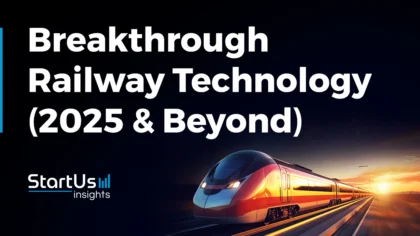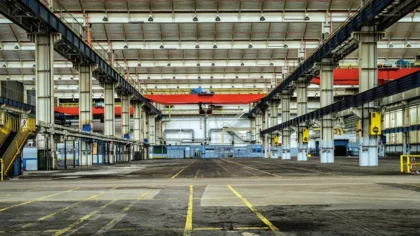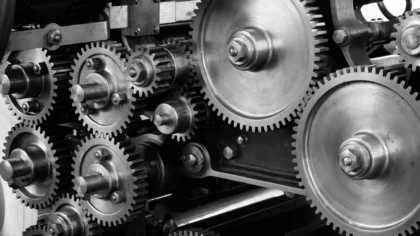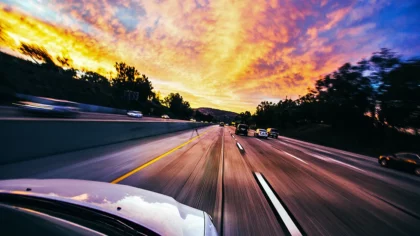Rail transportation is undergoing significant changes in response to the growing demand for fast transportation between and inside cities and countries. The major rail industry trends involve drones and smart sensors for inspecting railway tracks, digital communication platforms, and automatic train control (ATC). Notoriously slow to implement modern technologies, rail tech startups are working to scale various solutions that look to combine biometric information, artificial intelligence (AI), and cloud computing.
For train operators and railroad companies, the Internet of Things (IoT) devices enable the implementation of predictive maintenance to monitor for any anomalies. In addition to condition-based monitoring, newer rail industry trends such as rolling stock hybridization and high-speed rail also contribute to the growing pool of future-looking railway technologies.
This article was last updated in August 2024.
What are the Top Rail Industry Trends (2025)?
- Autonomous Trains
- Internet of Trains
- Artificial Intelligence
- Decarbonization
- Rail Connectivity
- Passenger Experience
- High Speed Rail
- Rail Automation
- Big Data & Analytics
- Augmented & Virtual Reality
Innovation Map outlines the Top 10 Railway Trends & 20 Promising Startups
For this in-depth research on the Top Railway Trends and startups, we analyzed a sample of 1633 global startups & scaleups. This data-driven research provides innovation intelligence that helps you improve strategic decision-making by giving you an overview of emerging technologies in the railway industry. In the Rail Industry Innovation Map below, you get a comprehensive overview of the innovation trends & startups that impact your company.
These insights are derived by working with our Big Data & Artificial Intelligence-powered StartUs Insights Discovery Platform, covering 4.7M+ startups & scaleups globally. As the world’s largest resource for data on emerging companies, the SaaS platform enables you to identify relevant technologies and industry trends quickly & exhaustively.
Want to explore all Rail Industry innovations & trends?
Tree Map reveals the Impact of the Top 10 Rail Industry Trends
Based on the Rail Innovation Map, the Tree Map below illustrates the impact of the Top 10 Rail Industry Trends in 2025. Startups and scaleups are working on developing new autonomous train systems that will increase the efficiency and reliability of railway transportation. These systems rely heavily on the development of the Internet of Things (IoT), artificial intelligence (AI), and connectivity technologies. Additionally, the zero-emissions initiatives drive the rail industry towards the implementation of decarbonization strategies.
Global Startup Heat Map covers 1633 Rail Startups & Scaleups
The Global Startup Heat Map below highlights the global distribution of the 1633 exemplary startups & scaleups that we analyzed for this research. Created through the StartUs Insights Discovery Platform, the Heat Map reveals that Europe is home to most of these companies while we also observe increased activity in India as well the USA.
Below, you get to meet 20 out of these 1633 promising startups & scaleups as well as the solutions they develop. These new technologies in railway systems were hand-picked based on criteria such as founding year, location, funding raised, and more. Depending on your specific needs, your top picks might look entirely different.
Top 10 Trends & Innovations in the Rail Industry (2025)
1. Autonomous Trains
Enabled by advanced sensor technology and real-time data transmission, the autonomous train is an effective solution for improving punctuality, reliability, and capacity optimization in the railway industry. Upgrades to signaling technology and automatic train control (ATC) systems reduce technical errors, improve traffic information flows, and reinforce passenger confidence in rail transit. For example, a grade-of-automation 4 (GoA4) system autonomously handles emergency situations and obstacle detection, as well as controls the train’s speed, brakes, and doors.
OTIV – ADAS for Light Rail
Belgian startup OTIV develops advanced driver-assistance systems (ADAS) and full self-driving (FSD) solutions for light rail and shunting operations. The startup uses artificial intelligence (AI), deep learning, computer vision, and sensors to develop the zero-emission OTIV Light Rail Vehicle System, adapting locomotives to urban environments. Equipped with object detection and collision avoidance technologies, ADAS and FSD systems further increase the safety and efficacy of rail transport.
GEAR International Holdings – Integrated Signaling
South African startup GEAR International Holdings provides integrated railway signaling solutions. The system uses train location information for interlocking and enables communications-based train control (CBTC). Additionally, the movement and interlocking of trains are integrated with wayside signaling control systems. The startup’s signaling solutions ensure safety, optimize train movement, and maximize the use of platform availability.
2. Internet of Trains
The internet of trains greatly impacts the reliability and safety of railway infrastructure. Condition-based monitoring prevents delays resulting from track and train part failures, which optimizes maintenance efficiency and costs, as well as improves passenger satisfaction. Additionally, IoT-enabled advanced analytics allows railway operators to find data-driven solutions to improve fleet control and rail operations efficiency.
TRAINFO – Railroad Crossing Monitoring
Canadian startup TRAINFO offers a cost-effective solution that helps reduce traffic delays at railroad crossings. The startup uses train sensors, Bluetooth, and prediction software to determine when to open and close rail crossings. This information is then conveyed to drivers through information systems, such as roadside signage, mobile apps, or traffic signaling. The startup’s solution also aids city planning officials when designing and operating railway crossings and other infrastructure.
HUM Industrial Technology – Predictive Monitoring & Fleet Tracking
The US-based startup HUM Industrial Technology offers predictive monitoring solutions to railroad shippers and railcar owners. The startup uses wireless IoT sensors for automated safety monitoring and prediction of wheel and bearing failure, as well as detection of oil or gas leakages. Additionally, the startup provides a live global positioning system (GPS) tracking solution offering a comprehensive overview of fleet location and history. The startup helps rail operators reduce maintenance costs by enabling early detection of potential failures.
3. Artificial Intelligence
AI finds numerous applications within the railway industry, encompassing asset management, predictive maintenance, and emergency notification. Deep learning algorithms and neural networks optimize train scheduling and minimize delays. Moreover, advanced passenger information systems improve transportation services and increase passenger satisfaction.
The Train Brain – AI-Enabled Traffic Planning and Control
Swedish startup The Train Brain develops AI models that improve the reliability of public transportation. The startup’s tool delivers delay forecasting, as well as real-time traffic simulations and reporting. The tool processes train schedules and signaling or global positioning system (GPS) data to conduct rail network forecasting. The Train Brain enables rail operators to make data-driven traffic planning decisions and passengers to be more informed when planning their commute or travel.
Cedar AI – Rail Yard Operations
US-based startup Cedar AI offers artificial intelligence solutions to help rail operators improve yard efficiency. The startup’s AI-powered platform integrates with existing software to ensure safety rule compliance during rail yard operations. The platform helps rail operators optimize yard processes and reduce workload while also improving the safety of train handling.
4. Decarbonization
Although railways are the most sustainable form of transportation, following ambitious net-zero emissions plans, governments are looking to further decarbonize the rail industry. The most common decarbonization solutions include replacing diesel trains with battery technology, hydrogen fuel cells, or electric trains. To further minimize CO2 emissions, rail operators deploy electric locomotives that use energy from renewable sources, such as solar or wind.
RIINO creates a Zero Emission Monorail
RIINO, a Canadian startup, offers a zero-emission monorail system that operates fully electric and automated. Its monorail system is adaptable for both underground and surface projects, making it suitable for diverse applications. This system is noted for its low maintenance costs and reduced underground ventilation needs, improving operational efficiency while lowering energy use and greenhouse gas emissions. RIINO’s technology advances rail industry decarbonization with its modular, autonomous, and fully electric monorail, also extending its benefits to the mining industry.
Hoeller Electrolyzer – Electrolysis Stacks for Hydrogen
The US-based startup Hoeller Electrolyzer provides polymer electrolyte membrane (PEM) electrolysis stacks for the manufacturers of green hydrogen systems. The startup offers its Prometheus Electrolysis-Stacks to optimize hydrogen fuel cell storage capabilities in electric and hybrid locomotives. This optimization increases the maximal output of PEM electrolysis and also lowers the costs of storing green hydrogen.
5. Rail Connectivity
Modern railway mobile communications systems, enhanced with 5G technologies, allow for low-latency communications and high performance, as well as the reliability of railway infrastructure. Further, communications-based train control (CBTC) enables efficient rail traffic management and asset monitoring. Train connectivity applications span train positioning, control, maintenance, passenger experiences, and passenger data collection.
Cnection – Automatic Vehicle Identification Software for Locomotives
UK-based startup Cnection offers Rail AVI – an automatic vehicle identification system to electronically track trains as they pass along the network. Cnection develops software that performs complex translation algorithms, which is useful for monitoring train movements across the rail network.
As trains pass by fixed trackside readers or handheld devices, the tags harvest radio energy from the reader and transmit a unique vehicle ID back within a second. Overall, Rail AVI provides an efficient electronic means of automatically identifying trains without slowing them down.
Passengera – Onboard Connectivity
Czech startup Passengera develops a platform that provides Wi-Fi connection and infotainment for railway passengers. The startup’s connectivity solution gives passengers access to onboard entertainment, and news, as well as travel and accommodation information via smart devices or laptops. Additionally, the startup’s connected solutions support the train’s passenger information and ticketing systems, route information, and CCTV cameras.
6. Passenger Experience
To improve passenger experience, rail companies employ automatic ticketing and video surveillance, set up train delivery services, and create train hotel experiences. Video surveillance detects theft and helps optimize passenger load. Further, smartphone and mobile apps automate ticketing and price comparisons for passengers and rail companies. Onboarding systems further improve last-minute booking, and identification control, as well as seat assignments, and infotainment systems engage passengers during travel. To further simplify the ticketing process and passenger identification, companies employ biometric ticketing solutions.
Save A Train – Dynamic Ticket Pricing
Save A Train is a startup from the Netherlands that creates dynamic ticket pricing solutions for both passengers and rail operators. Utilizing AI algorithms and big data, the company predicts train ticket prices and advises travelers on the optimal time to buy or exchange tickets. Additionally, Save A Train offers APIs, white-label services, and metasearch capabilities to rail operators. These solutions streamline the ticket booking process, making it more efficient.
RailRestro – Food Delivery to the Train Seat
Indian startup RailRestro offers food delivery services to train passengers. The startup’s online service allows contactless delivery to the passenger’s train seat from a range of accredited restaurants. The startup gives passengers an opportunity to transform a train ride into a culinary experience.
7. High Speed Rail
The development of high-speed rail systems is aimed at making the transportation of people and goods more efficient and frequent. HSR encompasses high-speed train and line design and construction. In particular, companies focus on both the adaptation of the existing infrastructure and the development of new high-speed systems such as hyperloop, which are capable of exceeding the speed of 1000 km per hour.
Zeleros – Autonomous Hyperloop Vehicles
Spanish startup Zeleros designs electric-powered autonomous hyperloop vehicles and infrastructure. The vehicle, driven by an electric powertrain, uses active magnetic levitation technology. Additionally, the startup develops an electric aerodynamic propulsion system for the vehicle to reduce the need for placing linear motors along the track and an electromagnetic launcher for vehicle range optimization.
NEVOMO – Passive Magnetic Levitation Train
Polish startup NEVOMO develops a magnetic rail system capable of reaching up to 550 km per hour. The train uses passive magnetic levitation and linear motor technology to further improve the transportation of people and goods. The startup’s technology allows the new-concept trains to operate on existing tracks alongside the conventional trains. Additionally, NEVOMO develops plans for enabling hyper-rail and hyperloop technologies.
8. Rail Automation
The automation of the railway industry goes beyond autonomous train operations (ATO). Startups and scaleups develop robotic systems for infrastructure cleaning and maintenance and drone technology for remote inspection. Additionally, traction control automation prevents delays and improves the safety of rail infrastructure. Smart rail automation helps railway companies optimize asset efficiency, monitoring, and maintenance, delivering improved experience and rail reliability for passengers.
RMT – Intelligent Track Video Analysis Systems
RMT is an Italian startup that offers RailScan. It is an intelligent track video analysis system for the automatic detection and classification of railway road equipment. RailScan detects missing, misaligned, broken, melded, or peeled track components including rail, fasteners, fish plates, and bolts. By leveraging high-resolution data, RailScan scans both the sides and top of the two rails. The automation of the visual inspection processes allows rail operators to efficiently maintain railway infrastructure.
Laser Precision Solutions – Rail Track Maintenance
Dutch scaleup Laser Precision Solutions develops laser technology solutions for track maintenance. The scaleup’s product, LaserTrain, addresses the low railhead adhesion issue that causes train delays due to autumn leaf deposits on the track. TriboMeter is another solution to measure real-time friction between the track and the train enabling the optimization of acceleration and energy consumption. By improving traction, the solutions reduce train delays and cancellations, as well as improve overall rail safety.
9. Big Data & Analytics
The use of big data in the railway sector paves the way for train communication, predictive analytics, asset management, passenger information systems, and data management platforms. By deploying smart railway sensors, millions of data points are gathered and analyzed to further improve the safety, security, and reliability of rail infrastructure. The ability to predict failures further allows rail operators to plan repairs, increasing the availability of rail. Startups and scaleups are developing IoT sensors to collect data for rail infrastructure, including railcars, tracks, and signaling units.
Raildiary – Project Management System
British startup Raildiary provides a data tracking platform for railway construction companies. The startup develops the Sitediary app, a platform for railway project management and analysis. The startup’s solution finds applications in rail, including maintenance, signaling, and electrification, as well as fatigue and emergency management. The solutions optimize the efficacy of rail construction projects to minimize delays, resource waste, and unnecessary costs.
Everysens – Railway Traffic Management
French startup Everysens provides Traffic Management System (TMS) solutions to railway shipping and freight forwarding companies. The startup’s proprietary platform, TMS Rail, combines AI and IoT to provide a real-time TMS solution for rail operators. The platform allows operators to make processes more efficient to eventually optimize end-to-end rail operations.
10. Augmented & Virtual Reality
The applications of mixed reality in the rail industry span personnel training, design visualization, and customer engagement. Interactive train windows provide infotainment and route information while augmented reality (AR) mobile apps allow passengers to take part in rail infrastructure design. Additionally, virtual reality (VR) headsets make training more immersive and informative. AR and VR solutions allow railway companies to reduce personnel training costs and improve passenger satisfaction and loyalty, increasing their sales.
VTrain – VR Platform to Train Transportation Workers
Uzbekistan-based startup VTrain is developing a no-code, VR education platform to quickly and cost-effectively train transportation workers. The platform allows users to easily create VR courses using predefined assets and scripts without coding. The solution also features custom modules that administrators can use to expand the functionality of the training. VTrain also provides a dashboard for trainers to manage the progress of learners.
VRTECH – Personnel Training
Dutch startup VRTECH offers VR design, demonstration, and training systems for personnel development and marketing. The startup develops a number of rail simulations to improve the skills of train inspectors and engineers. The startup also provides a railway station design simulation showcasing future services. This tool also allows passengers to experience various features of the station infrastructure.
Discover all New Rail Technologies, Trends & Startups
The rail trends and startups outlined in this report only scratch the surface of trends that we identified during our in-depth research. Among others, IoT-based communication technologies, AI, and high-speed rail advancements will transform the sector as we know it today. Identifying new opportunities and technologies to implement into your business early on goes a long way in gaining a competitive advantage. Get in touch to easily and exhaustively scout relevant technologies & startups that matter to you.


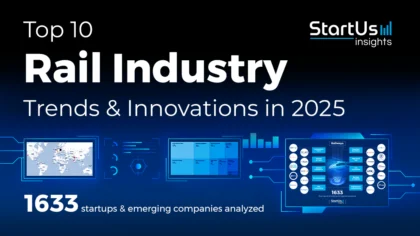
 WATCH THE VIDEO VERSION
WATCH THE VIDEO VERSION 


